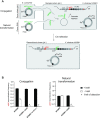Cassette recruitment in the chromosomal Integron of Vibrio cholerae
- PMID: 34048565
- PMCID: PMC8191803
- DOI: 10.1093/nar/gkab412
Cassette recruitment in the chromosomal Integron of Vibrio cholerae
Abstract
Integrons confer a rapid adaptation capability to bacteria. Integron integrases are able to capture and shuffle novel functions embedded in cassettes. Here, we investigated cassette recruitment in the Vibrio cholerae chromosomal integron during horizontal transfer. We demonstrated that the endogenous integrase expression is sufficiently triggered, after SOS response induction mediated by the entry of cassettes during conjugation and natural transformation, to mediate significant cassette insertions. These insertions preferentially occur at the attIA site, despite the presence of about 180 attC sites in the integron array. Thanks to the presence of a promoter in the attIA site vicinity, all these newly inserted cassettes are expressed and prone to selection. We also showed that the RecA protein is critical for cassette recruitment in the V. cholerae chromosomal integron but not in mobile integrons. Moreover, unlike the mobile integron integrases, that of V. cholerae is not active in other bacteria. Mobile integrons might have evolved from the chromosomal ones by overcoming host factors, explaining their large dissemination in bacteria and their role in antibioresistance expansion.
© The Author(s) 2021. Published by Oxford University Press on behalf of Nucleic Acids Research.
Figures








References
-
- Stokes H.W., Hall R.M.. A novel family of potentially mobile DNA elements encoding site-specific gene-integration functions: integrons. Mol. Microbiol. 1989; 3:1669–1683. - PubMed
-
- Mazel D., Dychinco B., Webb V.A., Davies J.. A distinctive class of integron in the Vibrio cholerae genome. Science. 1998; 280:605–608. - PubMed
-
- Cambray G., Guerout A.M., Mazel D. Integrons. 2010; 44:141–166. - PubMed
Publication types
MeSH terms
Substances
LinkOut - more resources
Full Text Sources
Other Literature Sources
Molecular Biology Databases

